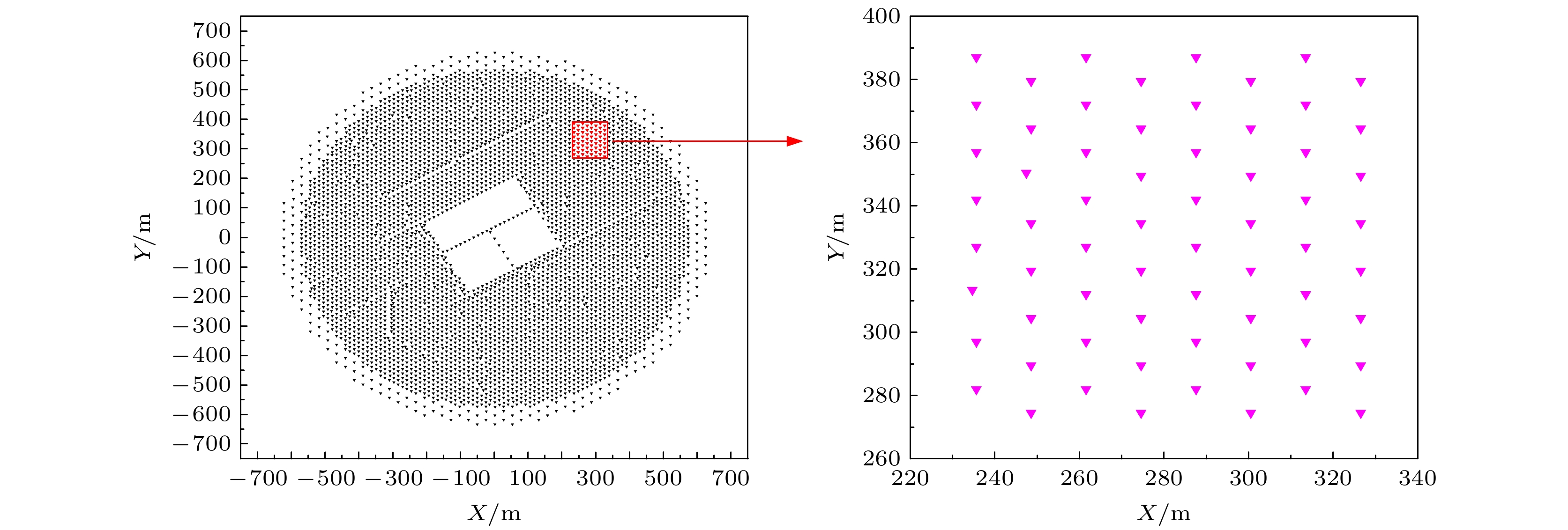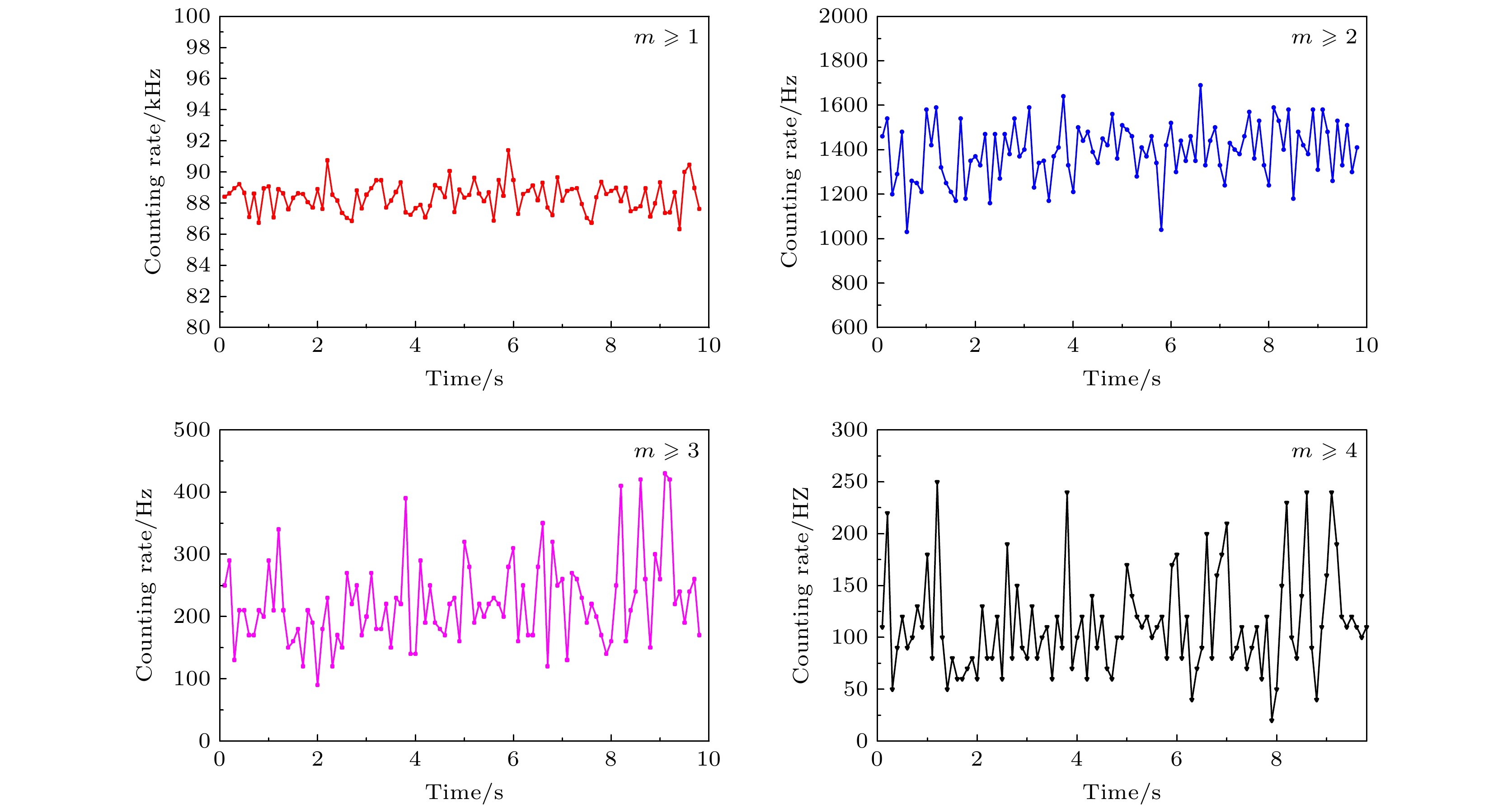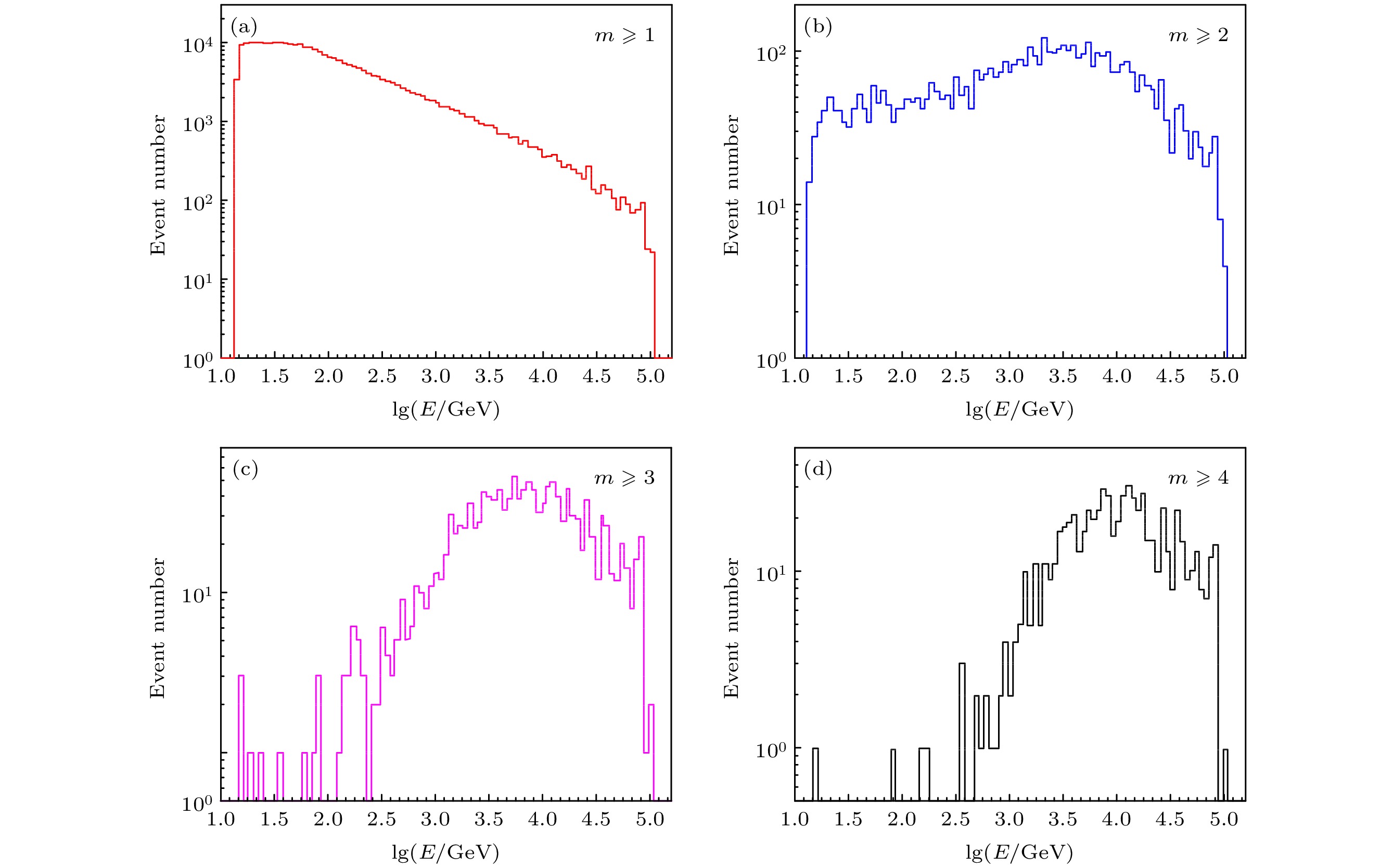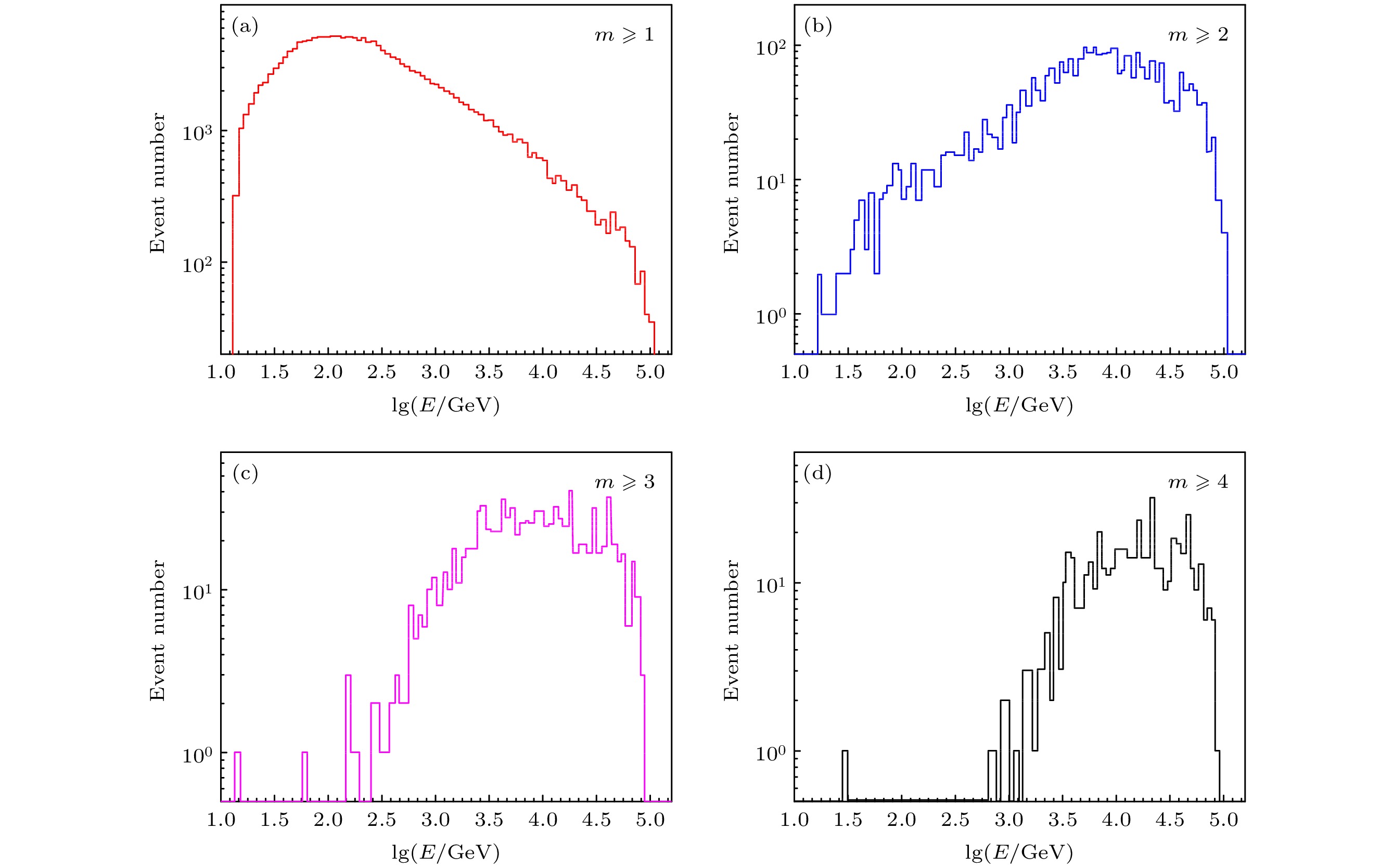-
位于四川省稻城县海子山的高海拔宇宙线观测站(LHAASO)包含3个子阵列, 即地面粒子探测器阵列(KM2A)、水切伦科夫探测器阵列 (WCDA) 和广角大气切伦科夫望远镜阵列(WFCTA). 作为LHAASO实验的主阵列, KM2A由5195个地面电磁粒子探测器(ED)和1188个地下缪子探测器(MD)组成. 对地面宇宙线观测实验来说, 常有两种独立的数据采集模式, 即shower模式和scaler模式. 本文通过Monte Carlo方法, 利用CORSIKA软件包和G4KM2A软件包, 对KM2A-ED阵列中的scaler模式进行了模拟研究. 当64个ED作为一个cluster、符合时间窗口为100 ns时, 多重数m ≥ 1, 2, 3和4的计数率分别约为 88 kHz, 1400 Hz, 220 Hz和 110 Hz. 对scaler模式探测原初宇宙线的能量和有效面积也进行了模拟计算, 发现KM2A-ED中多重数m ≥ 1 时探测原初质子的阈能可降低到100 GeV、有效面积高达100 m2. 本模拟结果为LHAASO-KM2A实验中进行scaler模式的数据触发提供了具体方案, 为后续的实验数据分析提供了信息.
-
关键词:
- 宇宙线 /
- Scaler模式 /
- Monte Carlo模拟
A large high altitude air shower observatory (LHAASO) located at Daocheng in Sichuan province, China, with an altitude up to 4410 m above the sea level, takes the function of hybrid technology to detect cosmic rays. It is composed of three sub-arrays: a 1.3 km2 ground-based particle detector array (KM2A) for γ-ray astronomy and cosmic ray physics, a 78000 m2 water Cherenkov detector array (WCDA) for γ-ray astronomy, and 18 wide field-of-view air Cherenkov/fluorescence telescopes array (WFCTA) for cosmic ray physics. As the major array of LHAASO, KM2A is composed of 5195 electromagnetic particle detectors (EDs, each with 1 m2) and 1188 muon detectors (MDs, each with 36 m2). In the ground-based experiments, there are two common independent data acquisition systems, corresponding to the shower and scaler operation modes. Up to now, the KM2A array operates only in shower mode with the primary energy threshold of about 10 TeV. In the scaler mode, it is not necessary for too many detectors to be hit at the same time. The energy threshold of the experiment can be greatly lowered. In order to learn more about the scaler mode in LHAASO-KM2A, we adopt the CORSIKA 7.5700 to study the cascade processes of extensive air showers in the atmosphere, and employ the G4KM2A (based on Geant4) to simulate the detector responses. The KM2A-ED array is divided into dozens of clusters. For one cluster (composed of 64 EDs), the event rates of showers having a number of fired EDs ≥ 1, 2, 3, 4 (in a time coincidence of 100 ns) are recorded. The average rates of the four multiplicities are ~88 kHz, ~1400 Hz, ~220 Hz, and ~110 Hz, respectively. The particle multiplicities m ≥ 3 are almost completely due to cosmic ray secondary particles. The corresponding primary energies and effective areas are also given in this paper. According to our simulations, the energy threshold of the scaler mode can be lowered to 100 GeV, and the effective areas reach up to ~100 m2. The simulation results in this work are helpful in the online triggering with the scaler mode, and provide information for the subsequent data analysis in LHAASO-KM2A.-
Keywords:
- cosmic rays /
- scaler mode /
- Monte Carlo simulations
[1] 张潇, 陈阳 2019 现代物理知识 31 9
Zhang X, Chen Y 2019 Modern Physics 31 9
[2] 周勋秀, 胡红波, 黄庆 2009 物理学报 58 5879
 Google Scholar
Google Scholar
Zhou X X, Hu H B, Huang Q 2009 Acta Phys. Sin. 58 5879
 Google Scholar
Google Scholar
[3] Bartoli B, Bernardini P, Bi X J 2017 Astrophys. J. 842 31
 Google Scholar
Google Scholar
[4] Abeysekara A U, Alfaro R, Alvarez C 2015 Astrophys. J. 800 78
 Google Scholar
Google Scholar
[5] Aharonian F, An Q, Axikegu 2021 Chin. Phys. C 45 025002
 Google Scholar
Google Scholar
[6] Aielli G, Bacci C, Barone F 2009 Astrophys. J. 699 1281
 Google Scholar
Google Scholar
[7] Di Girolamo T 2016 Nucl. Part. Phys. Proc. 279-281 79
[8] Bartoli B, Bernardini P, Bi X J 2015 Astrophys. J. 806 20
 Google Scholar
Google Scholar
[9] Bartoli B, Bernardini P, Bi X J 2015 Phys. Rev. D 91 112017
 Google Scholar
Google Scholar
[10] Bartoli B, Bernardini P, Bi X J 2015 Phys. Rev. D 92 092005
 Google Scholar
Google Scholar
[11] Vernetto S 2000 Astropart. Phys. 13 75
[12] Aielli G, Bacci C, Barone F 2008 Astropart. Phys. 30 85
 Google Scholar
Google Scholar
[13] Di Girolamo T, Vallania P, Vigorito C 2011 Astrophys. Space Sci. 7 239
 Google Scholar
Google Scholar
[14] Bartoli B, Bernardini P, Bi X J 2014 Astrophys. J. 794 82
 Google Scholar
Google Scholar
[15] Dasso S, Asorey H 2012 Adv. Space Res. 49 1563
 Google Scholar
Google Scholar
[16] Bartoli B, Bernardini P, Bi X J 2018 Phys. Rev. D 97 042001
 Google Scholar
Google Scholar
[17] 周勋秀, 王新建, 黄代绘, 贾焕玉, 吴超勇 2015 物理学报 64 149202
 Google Scholar
Google Scholar
Zhou X X, Wang X J, Huang D H, Jia H Y, Wu C Y 2015 Acta Phys. Sin. 64 149202
 Google Scholar
Google Scholar
[18] 徐斌, 别业广, 邹丹 2012 空间科学学报 32 501
 Google Scholar
Google Scholar
Xu B, Bie Y G, Zou D 2012 Chin. J. Space Sci. 32 501
 Google Scholar
Google Scholar
[19] Heck D, Knapp J, Capdevielle J N, Schatz G, Thouw T, https://www.ikp.kit.edu/corsika/70.php [2021-04-08]
[20] 陈松战, 赵静, 刘烨, 何会海, 侯超, 李秀荣, 张忠泉, 李骢, 刘佳, 李哲, 王玲玉 2017 核电子学与探测技术 37 1101
Chen S Z, Zhao J, Liu Y, He H H, Hou C, Li X R, Zhang Z Q, Li C, Liu J, Li Z, Wang L Y 2017 Nuclear Electronics & Detection Technology 37 1101
[21] 卢晓旭, 顾旻皓, 朱科军, 李飞 2020 核技术 43 80
Lu X X, Gu M H, Zhu K J, Li F 2020 Nuclear Techniques 43 80
[22] He H H 2018 Radiation Detection Technology and Methods 2 1
 Google Scholar
Google Scholar
[23] 曹臻, 陈明君, 陈松战 2019 天文学报 60 19
Cao Z, Chen M J, Chen S Z 2019 Acta Astronomica Sinica 60 19
[24] Cao Z, Chen M J, Chen S Z 2019 Chin. Astron. Astrophys. 43 457
 Google Scholar
Google Scholar
[25] Jin C, Chen S Z, He H H 2020 Chin. Phys. C 44 065002
 Google Scholar
Google Scholar
[26] Zhang Z Q, Hou C, Cao Z 2017 Nucl. Instrum. Methods A 845 429
 Google Scholar
Google Scholar
[27] Allison J, Amako K, Apostolakis J 2016 Nucl. Instrum. Methods A 835 186
 Google Scholar
Google Scholar
[28] Aguilar M, Aisa D, Alpat B 2015 Phys. Rev. Lett. 114 171103
 Google Scholar
Google Scholar
[29] Aguilar M, Aisa D, Alpat B 2015 Phys. Rev. Lett. 115 211101
[30] Aharonian F, An Q, Axikegu 2021 Nucl. Instrum. Methods A 1001 165193
 Google Scholar
Google Scholar
[31] Zhou X X, Gao L L, Zhang Y, Guo Y Q, Zhu Q Q, Jia H Y, Huang D H 2016 Chin. Phys. C 40 075001
 Google Scholar
Google Scholar
[32] Vallania P, Girolamo T Di, Vigorito C 2006 Proceedings of the 20th European Cosmic Ray Symposium, Lisbon, Portugal, September 5–8, 2006 p5
-
表 1 Scaler模式中不同多重数时的平均计数率和宇宙线贡献率
Table 1. Average rates and the contribution of cosmic rays in scaler mode.
多重数(m) ≥ 1 ≥ 2 ≥ 3 ≥ 4 平均计数率 88 kHz 1400 Hz 220 Hz 110 Hz 宇宙线贡献率 42.3% 62.3% 96.9% 99.7% 表 2 Scaler模式中探测原初质子和氦的平均有效面积
Table 2. Average effective area for primary Proton and Helium in scaler mode.
多重数(m) Proton: $ \langle $Aeff$ \rangle $ /m2 Helium: $ \langle $Aeff$ \rangle $ /m2 ≥ 1 129.69 73.07 ≥ 2 2.38 0.91 ≥ 3 0.67 0.49 ≥ 4 0.34 0.27 表 3 Scaler模式中探测原初质子和氦的平均能量
Table 3. Average energy of primary Proton and Helium in scaler mode.
多重数(m) Proton $ \langle $E$ \rangle $/GeV Helium $ \langle $E$ \rangle $/GeV ≥ 1 93.8 236.0 ≥ 2 1.4 × 103 5.4 × 103 ≥ 3 6.3 × 103 1.4 × 104 ≥ 4 9.5 × 103 1.9 × 104 -
[1] 张潇, 陈阳 2019 现代物理知识 31 9
Zhang X, Chen Y 2019 Modern Physics 31 9
[2] 周勋秀, 胡红波, 黄庆 2009 物理学报 58 5879
 Google Scholar
Google Scholar
Zhou X X, Hu H B, Huang Q 2009 Acta Phys. Sin. 58 5879
 Google Scholar
Google Scholar
[3] Bartoli B, Bernardini P, Bi X J 2017 Astrophys. J. 842 31
 Google Scholar
Google Scholar
[4] Abeysekara A U, Alfaro R, Alvarez C 2015 Astrophys. J. 800 78
 Google Scholar
Google Scholar
[5] Aharonian F, An Q, Axikegu 2021 Chin. Phys. C 45 025002
 Google Scholar
Google Scholar
[6] Aielli G, Bacci C, Barone F 2009 Astrophys. J. 699 1281
 Google Scholar
Google Scholar
[7] Di Girolamo T 2016 Nucl. Part. Phys. Proc. 279-281 79
[8] Bartoli B, Bernardini P, Bi X J 2015 Astrophys. J. 806 20
 Google Scholar
Google Scholar
[9] Bartoli B, Bernardini P, Bi X J 2015 Phys. Rev. D 91 112017
 Google Scholar
Google Scholar
[10] Bartoli B, Bernardini P, Bi X J 2015 Phys. Rev. D 92 092005
 Google Scholar
Google Scholar
[11] Vernetto S 2000 Astropart. Phys. 13 75
[12] Aielli G, Bacci C, Barone F 2008 Astropart. Phys. 30 85
 Google Scholar
Google Scholar
[13] Di Girolamo T, Vallania P, Vigorito C 2011 Astrophys. Space Sci. 7 239
 Google Scholar
Google Scholar
[14] Bartoli B, Bernardini P, Bi X J 2014 Astrophys. J. 794 82
 Google Scholar
Google Scholar
[15] Dasso S, Asorey H 2012 Adv. Space Res. 49 1563
 Google Scholar
Google Scholar
[16] Bartoli B, Bernardini P, Bi X J 2018 Phys. Rev. D 97 042001
 Google Scholar
Google Scholar
[17] 周勋秀, 王新建, 黄代绘, 贾焕玉, 吴超勇 2015 物理学报 64 149202
 Google Scholar
Google Scholar
Zhou X X, Wang X J, Huang D H, Jia H Y, Wu C Y 2015 Acta Phys. Sin. 64 149202
 Google Scholar
Google Scholar
[18] 徐斌, 别业广, 邹丹 2012 空间科学学报 32 501
 Google Scholar
Google Scholar
Xu B, Bie Y G, Zou D 2012 Chin. J. Space Sci. 32 501
 Google Scholar
Google Scholar
[19] Heck D, Knapp J, Capdevielle J N, Schatz G, Thouw T, https://www.ikp.kit.edu/corsika/70.php [2021-04-08]
[20] 陈松战, 赵静, 刘烨, 何会海, 侯超, 李秀荣, 张忠泉, 李骢, 刘佳, 李哲, 王玲玉 2017 核电子学与探测技术 37 1101
Chen S Z, Zhao J, Liu Y, He H H, Hou C, Li X R, Zhang Z Q, Li C, Liu J, Li Z, Wang L Y 2017 Nuclear Electronics & Detection Technology 37 1101
[21] 卢晓旭, 顾旻皓, 朱科军, 李飞 2020 核技术 43 80
Lu X X, Gu M H, Zhu K J, Li F 2020 Nuclear Techniques 43 80
[22] He H H 2018 Radiation Detection Technology and Methods 2 1
 Google Scholar
Google Scholar
[23] 曹臻, 陈明君, 陈松战 2019 天文学报 60 19
Cao Z, Chen M J, Chen S Z 2019 Acta Astronomica Sinica 60 19
[24] Cao Z, Chen M J, Chen S Z 2019 Chin. Astron. Astrophys. 43 457
 Google Scholar
Google Scholar
[25] Jin C, Chen S Z, He H H 2020 Chin. Phys. C 44 065002
 Google Scholar
Google Scholar
[26] Zhang Z Q, Hou C, Cao Z 2017 Nucl. Instrum. Methods A 845 429
 Google Scholar
Google Scholar
[27] Allison J, Amako K, Apostolakis J 2016 Nucl. Instrum. Methods A 835 186
 Google Scholar
Google Scholar
[28] Aguilar M, Aisa D, Alpat B 2015 Phys. Rev. Lett. 114 171103
 Google Scholar
Google Scholar
[29] Aguilar M, Aisa D, Alpat B 2015 Phys. Rev. Lett. 115 211101
[30] Aharonian F, An Q, Axikegu 2021 Nucl. Instrum. Methods A 1001 165193
 Google Scholar
Google Scholar
[31] Zhou X X, Gao L L, Zhang Y, Guo Y Q, Zhu Q Q, Jia H Y, Huang D H 2016 Chin. Phys. C 40 075001
 Google Scholar
Google Scholar
[32] Vallania P, Girolamo T Di, Vigorito C 2006 Proceedings of the 20th European Cosmic Ray Symposium, Lisbon, Portugal, September 5–8, 2006 p5
计量
- 文章访问数: 7624
- PDF下载量: 75
- 被引次数: 0














 下载:
下载:






